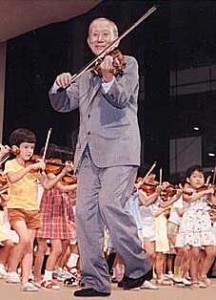 The Suzuki Method holds that every child can learn music. In the 1940s, Japanese violinist Shinichi Suzuki had an epiphany: it occurred to him that nearly all children around the world learn to speak their native language with ease. If young children can master something as complex as language, he reasoned, then they are also capable of learning to play music at a high level.
The Suzuki Method holds that every child can learn music. In the 1940s, Japanese violinist Shinichi Suzuki had an epiphany: it occurred to him that nearly all children around the world learn to speak their native language with ease. If young children can master something as complex as language, he reasoned, then they are also capable of learning to play music at a high level.
Dr. Suzuki began to apply the basic principles of language acquisition to the learning of music, and called this method the “mother-tongue’’ approach. The concepts of parental involvement, starting at a young age, loving encouragement, frequent repetition, learning with others and listening are some of the unique elements of the Suzuki approach.
Parents are directly involved in their child’s musical learning, just as they are when their child learns to speak. Through your attendance and careful note taking at lessons, you are able to be the “home teacher” during the week. Parents work with the teacher to create a productive and enjoyable learning environment for home practice.
Young children learn new words after hearing them spoken hundreds of times by others. The same concept applies to learning music: listening to music every day is crucial to your child’s musical development. It is especially important to listen to the piece in the repertoire on which your child is working or will begin working soon, as the actual learning of the piece takes place through listening.
Constant repetition is essential, in both language and musical learning. Children don’t learn a new word or piece of music and then discard it. Rather, they add it to their vocabulary or repertoire, gradually using it in new and more sophisticated ways. Repetition is crucial for developing mental processes and muscle coordination. This includes all aspects of playing – from proper physical alignment and balance to concentration, technique, and finally performance.
Each piece in the Suzuki repertoire is designed to present a new technical skill, to be learned in a musical context rather than solely through dry technical exercises. As a child’s “language” on the violin develops and becomes comfortable, note reading is introduced.
In addition to private lessons, children participate in regular group lessons and performance at which they learn from and are motivated and inspired by each other.
As with language, the child’s effort to learn an instrument should be met with sincere, honest praise and encouragement. Each child learns at his or her own rate. We build on small steps, taking the time needed to master each one. This fosters self-confidence, satisfaction, musicianship and beautiful tone.